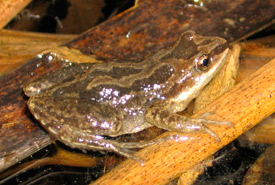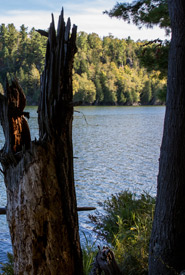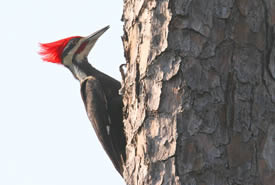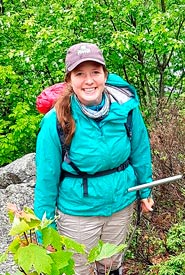Listening to the answers hidden in frog calls

Western chorus frog (Photo by Ryan Bolton)
Taking the time and effort to listen is essential to fully experiencing the outdoors. As a biologist, I am always keeping an eye and ear out for anything out of the ordinary, such as a rare frog, plant or bird species I’ve been hoping to spot. However, keeping up with other tasks, like trying to navigate with a GPS, cutting branches that are blocking the trail or pulling garlic mustard, makes it harder to notice discrete signs of rare species.
That makes the time we spend intently focused on surveying for rare species so rewarding. In late spring, staff from the Nature Conservancy of Canada (NCC) Ontario Region and I conducted surveys at Fishing Lake for the western chorus frog (Great Lakes–St. Lawrence–Canadian Shield population), a threatened species in Canada. We targeted suitable wetlands where the western chorus frog usually breeds, to get an idea of how many frogs reside in the area.
The easiest way to survey for frogs is by listening for breeding calls. Male frogs loudly call out to let females (and biologists!) know their location.

Trees at Fishing Lake, ON (Photo by Nick Tardif)
When I did my first western chorus frog survey, I was surprised by how quiet it was when my coworker and I stood still and just listened. The quietness allowed me to hear more clearly the more subtle sounds of nature around me.
A pileated woodpecker and gray tree frog called out in the distance, breaking the silence. Eastern kingbirds and red-winged blackbirds flitted through the wetland in search of food. We may not have heard a western chorus frog that day, but it felt good to know we had taken the time to listen.

Pileated Woodpecker (Photo by Bill Hubick)
Not to be discouraged, we continued the surveys into the following weeks. When we walked up the trail towards our survey site one morning, we were delighted to hear the trilling call of a male western chorus frog even before we reached the survey site. Not only had we heard what we had been searching for, but we had the listening skills to hear it while we were tromping along the trail.
When we arrived at the survey site and after three minutes listening intently for the frog’s call, we were slightly disappointed when we didn’t hear it again. Reflecting on this experience has taught me the importance of listening and practising the art of broadening my attention span. Increasing my attention span means that my senses are working consciously, scanning the environment for information, even when I am doing other tasks.
To open your ears to nature, try learning frog calls so you can identify frogs near you or in a wetland.


